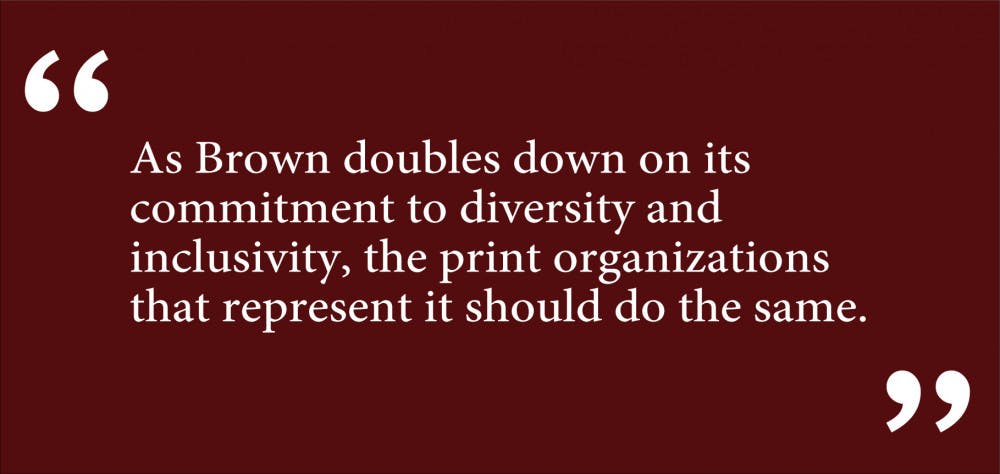Joel Stein and Nancy Gibbs. Gene Roberts. Anderson Cooper. The team from Spotlight. When I think of journalists who inspire me, these are the men and women who immediately come to mind. It is saddening that, off the top of my head, I can’t think of a single print journalist or columnist of color. For my birthday a few years back, my aunt and uncle gave me a copy of “The Race Beat,” a Pulitzer Prize-winning chronicle of black journalists who risked everything to publish news about the Civil Rights era. I didn’t recognize a single one.
This is symptomatic of the industry as a whole. According to the Atlantic, minority groups make up less than 14 percent of journalists at daily newspapers nationwide. This figure doesn’t represent a single minority group; it represents all of them. The statistic is pitiful — but, honestly, not surprising. The media industry, like other historically white fields (including government and medicine, to name two), thrives on unpaid internships and connections that a lot of underrepresented and low-income journalists simply do not have. Freelancing, career sabbaticals and living in our parents’ garages sometimes are not options. The assumption that writing will carry one’s career is rooted in privilege because good writing requires experience and often generates a smaller payout than other jobs, disadvantaging lower socioeconomic groups. Even studying journalism in schools can be daunting: When I shopped ENGL 1050H: “Journalistic Writing” and was told I’d have to find my own transportation across the city for interviews, not to mention allot more than 15 hours a week for one mandatory S/NC class, I balked. Nevertheless, English and modern culture and media concentrators try to do it anyway, and I applaud the bravery and dedication of those who have managed to stay in these departments. In the last decade, two-thirds of white graduates in journalism and communications found jobs out of college. Less than half of minority journalism graduates could say the same.
This lack of representation permeates written word and is a real issue for all kinds of journalism. We end up with tone-deaf articles like the infamous New York Times piece this summer that called boba, or bubble tea, “exotic,” “a new trend” and “so 2002.” Never mind that the drink exists all over Asian street corners and major American urban hubs. It’s the reason why crime headlines often feature mug shots of black and Latino men, but then post nice, professional class photos of white suspects (I’m looking at you, Brock Turner). These are not isolated incidents — they are consequences of an institutionalized system (one from which, if I may say, The Herald is not exempt).
I can’t help but compare this trend to the broader decline of print media over the last few years. BuzzFeed and the Huffington Post are taking up a greater market share of digital readers, and they represent an increasingly diverse public group. These organizations succeed (and are often scoffed at by the establishment) because they operate more on submissions, have wider pipelines for authors and democratize the writing process out of the hands of mostly old white men. Anyone can contribute to these sites; indeed, the articles that seem to thrive on these platforms often talk about taboo issues that other sources do not cover. There are issues with quality and accountability, of course, but these sites legitimize themselves because they have the ability to reach a wider audience.
Nevertheless, there is still a need to supplement these online resources with diverse viewpoints in ink and paper. Who would have thought that one of the most progressive media organizations to come out of this decade would be Teen Vogue? Young people are still reading print, and research shows that this form of media is more engaging than its online counterpart. In a world full of iPhones and PDFs, humans still find more legitimacy in paper and ink. Blogs and tumblrs might popularize ideas, but the written word physically cements these concepts for posterity. Print still holds a valuable place in our society.
As Brown doubles down on its commitment to diversity and inclusivity, the print organizations that represent it should do the same. They have a responsibility to present a diverse range of voices and recognize the structural barriers that impede that goal. At The Herald, the organization is working toward this, though there is still enormous room for improvement. But that improvement cannot materialize without help to shed light on stories that matter and have been brushed under the rug. So don’t take the tongue-in-cheek advice of Atlantic Editor-in-Chief Jeffrey Goldberg, who visited the University on Tuesday and discouraged others from exploring the field of journalism. If you have even a smidgen of interest in the many topics that this organization and others fail to cover and feel comfortable with sharing your ideas, try writing about them. The Herald, to take just one example, prints enough daily copies of the newspaper to build a paper-mache house and then some. Readership is practically guaranteed. And for better or for worse, it is a direct pipeline to alums, administrators and the institutional record of the University.
I speak from my own experience. When The Herald published racist and hurtful pieces in my freshman year, I decided to join the team because I believed that fixing white journalism began with me. You can do the same. You don’t have to consider yourself a career journalist (I sure don’t). Heck, if you want, you can even take my bi-monthly spot on this page. I’m just counting on you to make your words count.
Mark Liang ’19 can be reached mark_liang@brown.edu. Please send responses to this opinion to letters@browndailyherald.com and other op-eds to opinions@browndailyherald.com.





